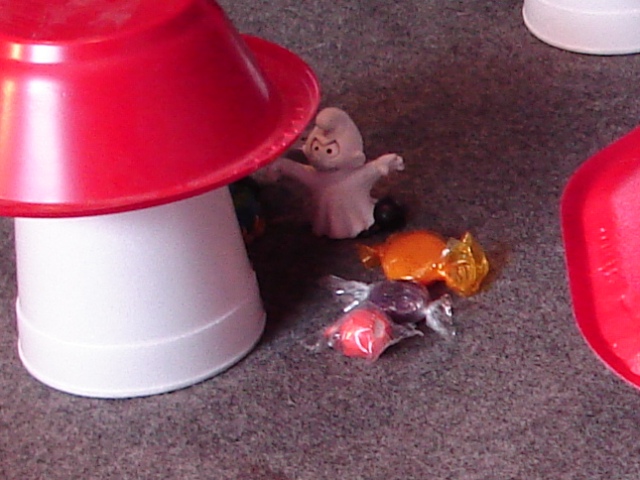
Vampirism and Lycanthropy Supplement
Magnificent! provides you a genre- and system-independent scenario based on the Shichi no Samurai/Magnificent Seven movies for 2 through 6 players. An asymmetric approach to victory conditions and the lack of formally assigned "teams" gives this game a refreshing twist on the standard slugfest. This scenario has been play tested with several of the popular gaming systems (which shall remain nameless to avoid the trolls and lawyers) in scifi, fantasy, pulp, and historical tabletop gaming.
Come get it for free on Wargame Vault !

OK ... This is not really a Smurf game. It is a general little trick-or-treat game with equal parts luck and strategy. It is shown here with the finely detailed figures and highly crafted terrain we have been using for a decade or so since we bought the Smurf toys.
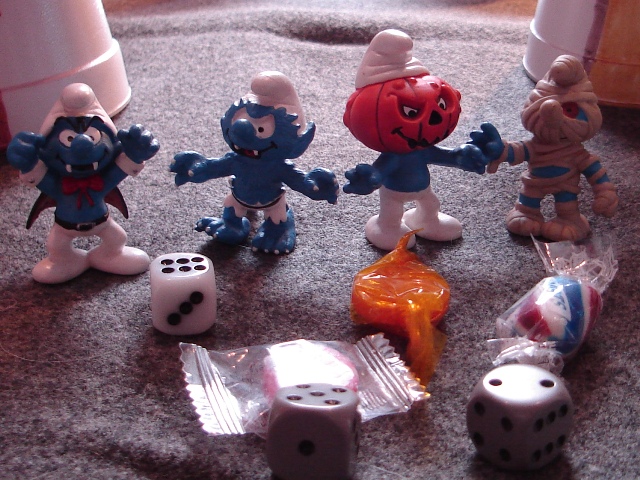
Pieces and Parts: This game plays well with anywhere from four to eight people, so you will need four to eight distinct figures. I suppose you could use colored plastic pawns, but this is Halloween and where's the fun in that? A nice visual distinction is important, too, since each figure will have a "special power". Even though you should have it written down, it is easier to remember that "The wolfman can run two spaces in one move." than "Green moves two."
You will also need some hollow terrain. The terrain will hide candies (the goal of the game) and part of the strategy is know where the loot is remiaining, just like knowing who gives away the good candy in your neighborhood.
Contests over candy are resolved with a die roll, so it is best if everyone has their own six-sided die.
The last piece is "movement cards". Movement of trick-or-treaters happens on a grid. Each turn there is the option to move to an adjacent house, so you will need some way to secretly select north, south, east, or west.
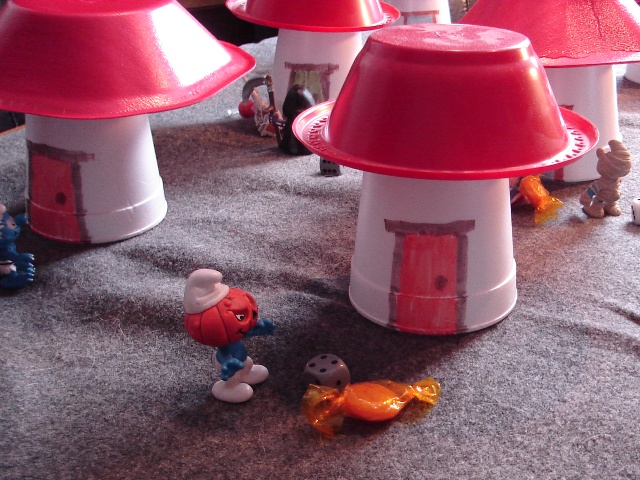
Setup: The field of play is nine houses, arranged in a tic-tac-toe like grid. Hidden under each house are thirteen pieces of candy. Each player selects one figure and places it on one of the outside squares of the grid. a grid direction for north is picked.
Play: The basic turn consists of Planning, Moving, and Being Cute (obtaining candy). First all the players secretly decide which direction their figure will move and place that card face down in front of them. Once all players have selected a move, the cards are turned face up and the pieces are moved to their new locations. Now the battle over candy commences!
If a figure is alone at a house, its player gets three pieces of candy. If there is more than one figure at a house, players roll a die. The highest roll (even if more than one player rolls it) gets two pieces of candy; the remaining players get one. If a house runs out of candy during distribution, players have a roll off to determine the order of getting pieces. If a house is out of candy when figures arrive, all players with figures at that house remove their figure from the board and are out of the rest of the game. When all players are out of the game, the player with the most candy (including ties) gets to bogart one piece of candy from the other players. If you eat your candy during the game, it does not count toward your end of game total.
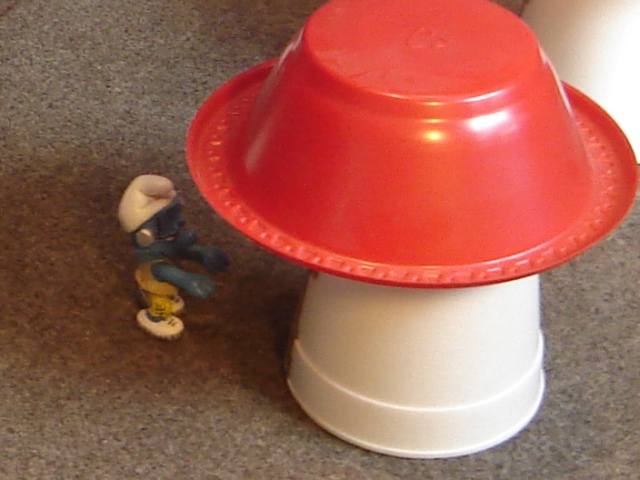
Powers Why use trick-or-treat monsters if they don't get special abilities for their costumes? Well,
that's what we thought too, so here are the eight abilities and (our) associated costumes:
Frankenstein's Monster - If there is more than one other figure at a house, add one to Frankie's roll.
Ghost - After everyone moves, you can send one figure at your house back where they came from.
Witch - If she rolls second highest when competing for candy, she also gets two pieces.
Mummy - If removed from the game, after skipping a turn, bring the Mummy back to a corner square.
Dracula - If Drac passes a figure during the move, have a roll off. If Drac wins (not ties), he takes one
piece of candy from one figure he passed. If he looses, the opposing player eats one of his candies. A tie
means no effect.
Punkinhead - After everyone moves, Punky can choose to go back to the house he came from before candy contests.
Wolfman - After everyone moves, the wolfman can choose to move one more space in the selected direction, if possible.
Variants: The easiest variant is more or fewer pieces of candy under each house. Another easy variant is to change the number of hourses. A four by four seems to work about the same, just resulting in a longer game. If you go for a five by five, i would recommend removing four or five hosues to create "voids" in the grid. Figures can't move into the voids. If they accidentally do, they loose a piece of candy and move back for that turn. It is cool to mark the voids with some spooky Halloween decoration.
It is possibly to muck about with the powers. It is also easy to come up with one that throws the whole game out of balance. Only the wolfman and witch power are the same as they were when we thought this game up. If you want to do it, play test new ideas one at a time, swapping them in and out for different other powers. If you get a good one, contact us and we'll add it here for you.
Since the Anne Rice's The Vampire Lestat came out our group has been futzing with the idea of vampirism and lycanthropy as regular diseases as opposed to occult happenings (which the Vampire Chronicles gravitated back to). It has been a fun exercise, and the result is this two-pager (with sample tracking charts) that gives a genre-independent method for implementing a non-run-of-the-mill bout of vampirism or lycanthropy for your campaign. Instant infection and transformation is a ton of fun in From Dusk Til Dawn, but this material is designed to lurk beneath the skin of your campaign to torture your players. A few (geez ... almost fifteen) years of playtesting has seen this approach be born completely unfit, bloat up to several dozen pages, then refine back down to a couple of pages of broken in and usable guidelines. Enjoy!
Grab a copy free from Wargame Vault!
We all love some dynamism in our games, especially when it forces players to consider options other than "hit fast ... hit hard" as the optimal strategy. While we love a dynamic environment, we don't love things that slow play d o w n. This article provides a simple and quick system for adding dangerous (exploding) terrain to your game that responds to missed attacks. The approach adds a few quick requirements to in game play, and offloads most of the work, including support for multiple variants, into pre-game activities, several of which can even be done before setup starts (i.e., before people show up, the day before, etc.).
The main element for the approach is the "generic modern storage pod container". A barrel. We sell some good, inexpensive ones to use on Ebay , but you could easily make your own by gluing two plastic bottlecaps together, spraypainting them a solid color, and then sealing the outside. Or using something else. Two key points: (1) you need a whole lot of them (so pick something cheap ... like our barrels! :), and (2) they need to be (functionally) identical (kinda like our barrels ... hint, hint).
 So, what do we do with this ton of mostly identical barrels? The first thing is to mark the
bottom side of a few of them (2 of 10 is nice) with a "diamond" diagram. These will be the
explody-type barrels. You can easily tell them apart from other barrels ... unless you flip
them over!
So, what do we do with this ton of mostly identical barrels? The first thing is to mark the
bottom side of a few of them (2 of 10 is nice) with a "diamond" diagram. These will be the
explody-type barrels. You can easily tell them apart from other barrels ... unless you flip
them over!
And flip them over is just what we will do. Take your marked barrels and mix them in, marked side down, with the non-marked ones. Now select an appropriate terrain effect for the barrels, based on your system. If your system of choice requires attack stats or uses stat cards, you can write the stats for all barrel explosions on a single business card for reference. They should also provide light cover and a moderate amelioration of movement, as appropriate for your system. All this can happen before anyone even arrives for the game. During set up, the players should take a couple turns mixing up the barrels so no one knows which are which. Then deploy them on the board just like you would "normal" terrain for your scenario.
During play, when a barrel is directly behind the target of a missed ranged combat attack, that barrel (only the closest one) is turned over. If it is a marked barrel, treat it like your system's basic grenade-type attack at that spot. Marked barrels are removed from play. Other barrels are replaced on their spot.
During play, when a barrel is within close combat distance of the attacker or defender in a missed close combat attack, that barrel (only the closest one) is turned over. If it is a marked barrel, treat it like your system's basic grenade-type attack at that spot. Marked barrels are removed from play. Other barrels are replaced on their spot.
There you go. Pretty simple. And it doesn't seem to make a lot of difference. Until the first barrel explodes. Then all the sudden, you're second guessing where you place your figures and whether or not to shoot at that enemy right next to your guy. :)
Variations This approach is strucutred to support a lot of variations fairly easily. The simplest is to vary the density of marked barrels. This variation can be expanded by having two (or more) pools of barrels with different densities of marked barrels. You can also vary which players know the densities (though it takes some pretty elaborate mixing to keep both players in the dark).
Another simple variation is to have different types of effect. To keep it simple, I recommend using other existing weapon effects from your system, for example, more/less powerful attacks, stun effects, or "push" effects that move figures (if you have them in your system). The different effects might necessitate additional different markings. Our method is to use clubs, hearts, and spades as the other marks (oh ... that's why you started with diamonds). This makes a nice alignment with a deck of cards for using more complex systems. Another option instead of multiple markings could be to have several business cards with effects on them, shuffled. Then on each barrel explosion, draw a new effect (either in sequence, or with replacement).
If you go the clubs, diamonds, hearts, spades route, you can step up the intrigue by superimposing the good old "memory" card game in a couple of ways. The basic memory game skips the exploding of barrels for missed attack (if you want; you don't have to) and requires a player to turn over two barrels after the end of his turn, but before the next player's turn. If the symbol on both match, then both explode. If not, they are replaced on the board. A slighlty different variant has the player first turn over the top card in a shuffled deck, then a barrel. If the suits match, the barrel explodes, otherwise it is replaced. A slightly crueler version requires the player to turn over the barrel before the card. If you liked the double blind idea from above, one player can bring the barrels with his distribution of marks, and the other can arrange half a deck of cards with his own custom distribution of suits. Or both players could bring half a set of barrels and half a deck of cards with their selected distributions.
So, even if you have double-double blind mixing of barrels and playing cards that run off a stack of double blind randomized business card effects, during play you have only added turning over a barrel and a card, and sometimes a second card and rolling an extra attack. Not a bad bit of addtional depth for a couple of one or two second actions.
QILS Effects The above rules can be used for pretty much any tabletop wargaming system. This last section provides some rules that are specifically for our Quick Intermediate Level Skirmish game. It's free and pretty cool, we think. So, if you already got it, here's a free tailoring of the above rules for QILS. And if you don't ... check it out. It's free.
Terrain Effect Barrels count as terrain with one level of hindrance. Even if placed within terrain with a higher hindrance, apparently, its easier to slide over a metal container pod than to keep trecking through the knee-deep muck it is in. For obscurance, there are two options: (1) just count it as adding two obscurance, (2) use the "head-waist-foot" method.
The head-waist-foot method assumes you have models where these three things are easily identifiable. You will need to evaluate three different lines of sight from the attacker's head to the defender's head, from the attacker's head to the defender's waist, and from the attacker's head to the defender's feet. Each of these lines of sight that are blocked adds one level of obscurance. We've playtested the h-w-f method quite a bit and will be using it in an upcoming sci-fi QILS supplement. The overwhelming majority of the time, nobody feels the need to pull out a straightedge on this. It's just "Can't see his feet", or "Can't see her below the waist."
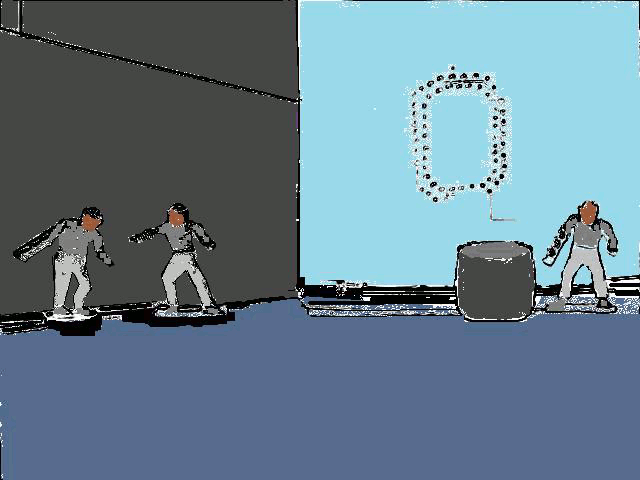
Explosive Effect The explosion attack is an area of effect close combat attack (giving it a little interesting flavor). All figures (no matter which side) within one range ring get attacked with a close combat attack. The attacker rolls an all red die (or just any die and counts all spots) and each defender (including ones on the attacker's team) roll for defense. The close combat attack counts for damage and also counts as a push attack.